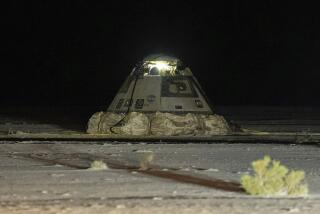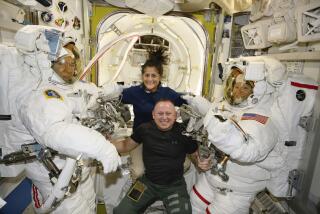Astronauts Turn Plumbers to Tackle Leak on Shuttle
- Share via
HOUSTON — Thursday was a “relatively easy day in orbit” for the five astronauts of the space shuttle Columbia, NASA officials said, despite the fact that they had to spend three hours sopping up one to two gallons of water from a leaky dehumidifier.
Their schedule had purposely been kept light in case the launch of a Navy communications satellite, successfully deployed Wednesday, had to be moved back a day.
After the cleanup, pilot Daniel C. Brandenstein spent most of the day making a series of small rocket burns that will bring the shuttle within 35 feet of the failing Long Duration Exposure Facility by 6:48 PST this morning. At that time, mission specialist Bonnie J. Dunbar will grapple it with the shuttle remote manipulator arm.
The leaking water was discovered in mid-deck by Brandenstein early Thursday. The crew immediately switched to a backup dehumidifier and he and mission specialist G. David Low spent more than two hours cleaning up the water, which collected in large and small globules around the apparatus.
The pair used towels and a vacuum hose to collect the water before it could damage sensitive electronic equipment, then dried cables and other apparatus by shining a flashlight on them.
Surveying the mid-deck mess in the middle of the cleanup, Brandenstein told Houston: “I’ll get the plumber-of-the-year award, but not the housekeeper-of-the-year award.”
At one point, capsule communicator Frank Culbertson in Houston remarked that “it’s a good thing those Navy boys have to go through Bilge Cleaning 101.” Brandenstein is a Navy captain, pilot James D. Wetherbee a lieutenant commander.
NASA officials later said the dehumidifier had been clogged by lint and lithium hydroxide dust, but that the leak would not impair the shuttle’s main mission: capture of the LDEF, which will crash into the atmosphere if not retrieved by Columbia.
When the astronauts arose late Thursday night they were in roughly the same orbit as LDEF and about 390 nautical miles behind it. With the rocket firings Thursday, they expected to be about 50 nautical miles away when they wake up this morning.
Another three computer controlled firings will bring them to within a few hundred feet of LDEF, at which time Brandenstein will take over the controls and manually fly the ship to within about 35 feet of the satellite.
Columbia will fly underneath LDEF, then come up in front of the satellite with the ship perpendicular to the Earth and the payload bay doors pointing toward the satellite. This approach was chosen because it requires the least amount of maneuvering.
Once Columbia is close enough to LDEF, Dunbar will grasp it with the 50-foot-long, $100-million remote manipulator arm and hold it for about 4.5 hours while mission specialist Marsha S. Ivins takes pictures of all 57 experiments aboard from the mid-deck area. Dunbar will then gently lower the satellite into a specially built cradle in the payload bay.
NASA officials anticipate no problems with loading the 12-ton, schoolbus-sized satellite into the cradle. In fact, when LDEF was deployed with the remote manipulator arm in 1984, the astronauts successfully tested reloading the satellite before finally releasing it into orbit.
The 10-day mission is scheduled to end next Friday with a 2:47 a.m. PST landing at Edwards Air Force Base in California.
More to Read
Sign up for Essential California
The most important California stories and recommendations in your inbox every morning.
You may occasionally receive promotional content from the Los Angeles Times.










